
The answer is F1 of course, maybe the more interesting question is by how much. A warning, this piece is strictly for F5000 anoraks.
Some recent chatter among enthusiasts on the The Nostalgia Forum’s Ontario Raceway thread got me thinking about the relative speed of F1 and F5000 cars. The builder/promoters of the then new Ontario facility ran an F1/F5000 race won by Mario Andretti’s Ferrari 312B in early 1971, see here; https://primotipo.com/2015/10/30/questor-grand-prix-ontario-speedway-1971/
In those far away days the Race of Champions at Brands Hatch pitted the two categories together, the only occasion on which an F5000 car beat the Effwun jobbies ‘fair and square’ was in 1973 when Peter Gethin triumphed in a Chevron B24 Chev. The 1971 Italian GP winner was running third when Mike Hailwood’s leading Surtees TS14A Ford and Denny Hulme’s following McLaren M23 Ford F1 cars had mechanical troubles gifting Gethin the win. Peter had only qualified eighth though.
Its ‘raw speed’ I am more interested in.


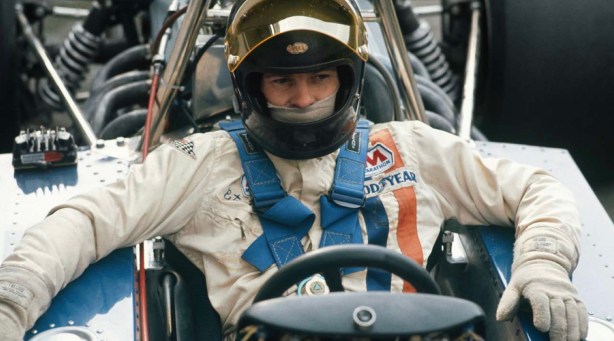
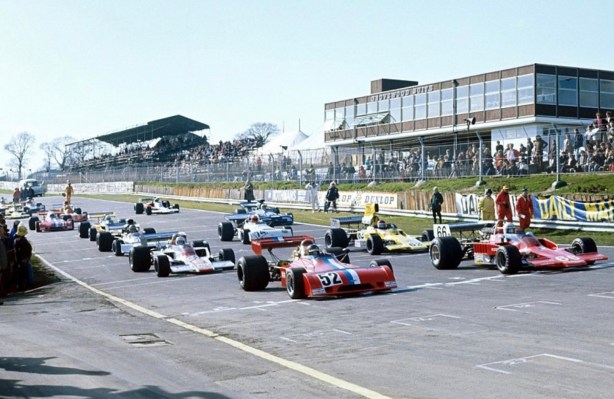
During the peak years of the European and US F5000 championships both categories raced on some of the same tracks, viz; Brands Hatch, Silverstone, Zandvoort, Zolder, Monza, Mosport and Watkins Glen.
So. If we look at the fastest race laps in each event by the cars on the track in the same year, eg; the Italian GP and Euro F5000 round at Monza, we can calculate the difference in lap times. Originally I thought qualifying times would be the go but F1 had greater use of qualifying tyres than F5000 so race times are a fairer representation.
The obvious flaw in the logic above is that absolute comparisons can only be made by looking at performances on the same day with each class racing in identical climatic conditions. So we will not arrive at absolute answers but indicative ones.
What year do we use? To get the greatest spread of meetings let’s use 1974. By that stage the greatest F5000 car(s) of all, the Lola T330-332 was in its second year of development. I suspect (but can’t be bothered doing the comparison) that the difference in times between F1 cars and F5000 in 1970-1971 would have much more as the only great-F5000 then was the McLaren M10B. Mind you it’s father is McLaren’s 1968 F1 machine, Robin Herd and Bruce’s McLaren M7. By 1974 there were plenty of very competitive bespoke F5000s from Lola, McRae, Chevron, Matich et al.
In 1975 there were circuit changes (chicanes added) at Silverstone and Watkins Glen between the F5000 and F1 races which make comparisons impossible. After a shitfight over dollars (what else?) the Canadian GP at Mosport wasn’t held, and Monza held an F5000 race, in 1975 they didn’t. Further, in Europe, from 1975, the championship admitted the Ford 3.4-litre quad-cam, four-valve V6 engine with which Alan Jones and David Purley were very fast.
The comparison I am after is ‘one of purity’ between 3-litre F1 cars and 5-litre F5000s as originally concepted, so for all those good reasons 1974 it is.
Remember, it’s fastest lap of the race I have recorded, not pole.
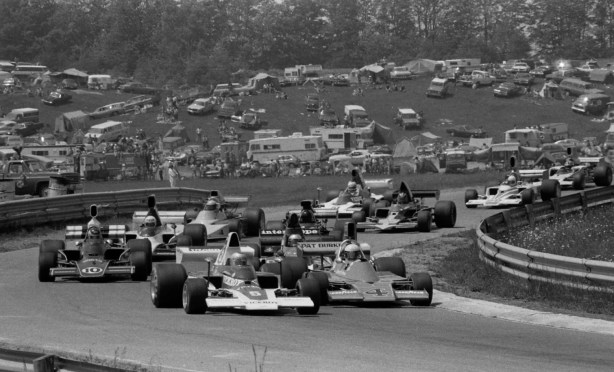
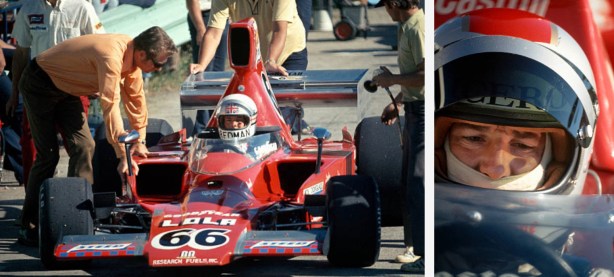
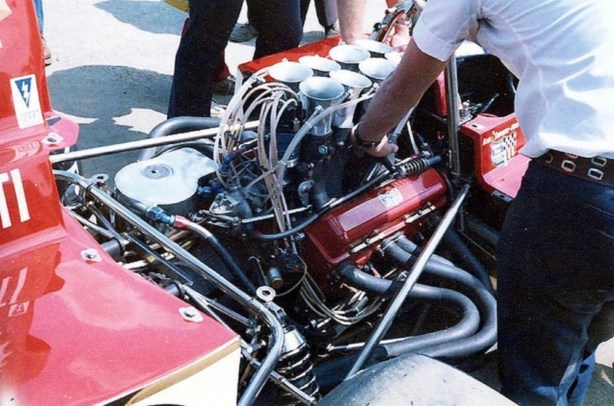
Brands Hatch
F5000 16/03/74 1:25.90 Peter Gethin Chevron B28 Chev
F1 20/06/74 1:21.10 Niki Lauda Ferrari 312B3-74
Zandvoort
F5000 03/06/74 1:23.30 Peter Gethin Chevron B28 Chev
F1 23/06/74 1:21.44 Ronnie Peterson Lotus 72E Ford
Monza
F5000 30/06/74 1:37.40 Peter Gethin Chevron B28 Chev
F1 08/09/74 1.34.20 Carlos Reutemann Brabham BT44 Ford
Mosport
F5000 15/06/74 1:16.200 Brian Redman Lola T332 Chev
F1 22/09/74 1:13.659 Niki Lauda Ferrari 312B3-74
Watkins Glen
F5000 14/07/74 1:41.406 Mario Andretti Lola T332 Chev
F1 06/10/74 1:40.608 Carlos Pace Brabham BT44 Ford
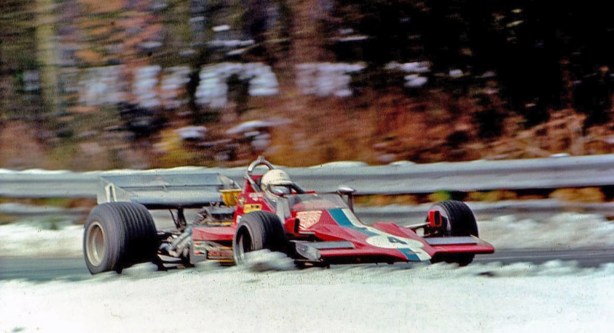


In making the assessment I’ve not considered the weather.
The biggest gap between the two classes is about four seconds at Brands, the smallest is one second at Watkins Glen.
Brands in March can be awfully chilly, and glorious in June, ambient temperature impacts the heat and grip of the tyres of course. Denis Jenkinson’s race report of the Brands F5000 race weekend (actually the Race of Champions weekend in which the F5000 championship race was on Saturday, the ROC on Sunday) does not help me as to weather conditions, but he makes no mention of rain. Similarly, the British GP was run in the dry. If you can help with mitigating weather or circumstances do get in touch.
Interestingly, Mario Andretti is on record in a number of publications as saying Vels Parnelli never approached the F5000 times set by the teams Lola T332 at Riverside and Watkins Glen in their F1 Parnelli VPJ4 Ford in testing, but then again that was not a great GP car.
The fastest F5000 cars on the planet in that period were the Haas-Hall and VPJ T332s raced by Brian Redman, Mario Andretti and Al Unser – what an awesome road-racer he was!
Bang-for-buck there has never been a greater single-seater class. It seems incredible today that, having killed the Can-Am Championship, the SCCA also slaughtered their F5000 Championship in the forlorn hope of recapturing Can-Am spectator interest and numbers.
In 1975-76 US F5000 had Redman, Andretti, Unser, Jones, Gethin, Oliver, Brown, Schuppan, Pilette, Ongais, McRae, Lunger and others. The Dodge powered Shadows added much needed variety to Formula Lola, mind you. Jones won a couple of races in 1976 with a March 76A Chev, it really was a brilliant blood and thunder spectacle even if the cars were not quite as fast as F1…

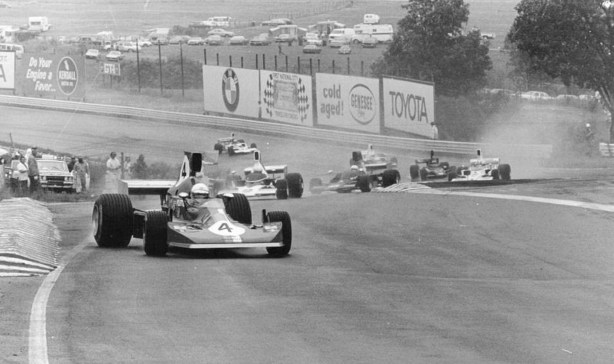
Credits…
Wikipedia, MotorSport, Autosport, Getty Images, Alan Cox, Jonesy Morris, Zolder Museum, Norm Macleod, Larry Roberts, Mike Hayward Collection, Steve Jones, Teddy Pilette Collection
Tailpiece…

The great Brian Redman’s Lola T332 Chev looking as good as a racing car ever gets. Turn 9 at Laguna Seca in 1975, Brian was third that day behind the VPJ duo of Andretti and Unser, also aboard T332 Chevs.
What an amazing career in single-seaters and sportscars he had, while Brian dipped in and out of F1 from the mid 1960s to the mid 1970s he must be up there in any list of ‘greatest driver of the period outside Grand Prix racing’.
Finito…
Add to that the fact that an F1 is a tailored suit, and an F5000 chassis is a shirt that you can buy in any window.
I believe that under equal conditions of design and cost, a 5,000cc, 2 valves per cylinder, will go together with a 3,000cc, 4 valves.
But there was a lot of top formula per square meter on the planet, maybe there wouldn’t be room for everyone.
Anyway, my favorite car and driver in this extinct world was the Chevron B24 with its brave warrior Peter Gethin.
I was an early F5000 fan. Hockenheim offered a pretty fair comparison in 1970. The fast F1 lap was Jackie Ickx in the Ferrari 312B 2:00.5 and a month later Frank Gardner ran 2:02.4 in the Lola T190. Track conditions were the similar: it was quite warm for F1 and a little cooler for F5000 but the track would have been cleaner for F1, lots of support races for F5000.
Hi Jim,
Great to hear from you, the F5000’s blasting thru the Hockenheim forest would have been memorable.
The other aspect to it is what they were like to drive comparatively.
Blokes with a lot, or enough experience of both in that mid-seventies period to help us are Andretti, Jones, Redman, Schuppan, Ashley and a bit later Perkins (of F5000), not that i know any of them. 520 pounds of cast iron sitting relatively high behind you and 500 foot/pounds of torque throwing you at the horizon are obvious but it would be interesting to have it put into digestible words all the same!
Mark
Let’s not forget the other time contemporary F5000 beat contemporary F1.
Sept 71 Frank Gardners’ T300 beat Emerson Fittipaldi ‘s Lotus 56 Turbine at Hockenheim.
Peter Gethin also put his M10 on the front row at the International Trophy at Silverstone in 1970 (admittedly 4 car’s wide in those days)
Thanks Gordon,
Had forgotten that one despite being an FG fan!
Mark
There is also a question within a question: Which version of F5000 was faster, US or EU ? Gethin seems to have been the best of the EU crew, but are there meaningful comparisons stretching across the pond ? Another data point would be the US GP at Long Beach, first held in 1975 for F5000 as a warm up for F1 the following year. Circuit layout and weather were identical for the 2 races. 1975 FL 1:19.90 Tony Brise Theodore Lola 332 1976 FL 1:23.09 Clay Regazzoni
Hi,
Without trying to prove it, I doubt one could, my gut reaction is that the 1975-1976 US Championships were the most competitive of any on the planet. Many of the European hot-shots raced there as well as young-thrusters on the way up.
Mark
[…] More F5000; https://primotipo.com/2020/09/15/which-was-quicker-f1-or-f5000/ […]